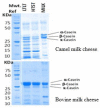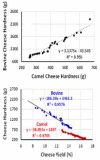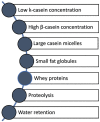The Texture of Camel Milk Cheese: Effects of Milk Composition, Coagulants, and Processing Conditions
- PMID: 35520282
- PMCID: PMC9062519
- DOI: 10.3389/fnut.2022.868320
The Texture of Camel Milk Cheese: Effects of Milk Composition, Coagulants, and Processing Conditions
Abstract
Numerous people in African, Middle Asian, Middle Eastern, and Gulf Cooperation Council (GCC) countries highly value camel milk (CM) as it plays a vital role in their diet. The protein composition of CM as well as the structure of its casein micelles differs significantly from bovine milk (BM). Cheeses made from CM have a weak curd and soft texture compared to those made from BM. This review article presents and discusses the effect of milk protein composition, processing conditions (pasteurization and high-pressure treatment), and coagulants (camel chymosin, organic acids, plant proteases) on the quality of CM cheeses. CM cheese's weak texture is due to compositional characteristics of the milk, including low κ-casein-to-β-casein ratio (≈0.05 in CM vs. ≈0.33 in BM), large micelle size, different whey protein components, and higher proteolytic activity than BM. CM cheese texture can be improved by preheating the milk at low temperatures or by high pressure. Supplementing CM with calcium has shown inconsistent results on cheese texture, which may be due to interactions with other processing conditions. Despite their structure, CM cheeses are generally well liked in sensory studies.
Keywords: bovine milk cheese; camel milk cheese; coagulants; high pressure processing; pasteurization.
Copyright © 2022 Mbye, Ayyash, Abu-Jdayil and Kamal-Eldin.
Conflict of interest statement
The authors declare that the research was conducted in the absence of any commercial or financial relationships that could be construed as a potential conflict of interest.
Figures





Similar articles
-
Effects of Pasteurization and High-Pressure Processing of Camel and Bovine Cheese Quality, and Proteolysis Contribution to Camel Cheese Softness.Front Nutr. 2021 Jun 17;8:642846. doi: 10.3389/fnut.2021.642846. eCollection 2021. Front Nutr. 2021. PMID: 34222297 Free PMC article.
-
The effects of camel chymosin and Withania coagulans extract on camel and bovine milk cheeses.Sci Rep. 2021 Jun 30;11(1):13573. doi: 10.1038/s41598-021-92797-6. Sci Rep. 2021. PMID: 34193923 Free PMC article.
-
Effects of blends of camel and calf chymosin on proteolysis, residual coagulant activity, microstructure, and sensory characteristics of Beyaz peynir.J Dairy Sci. 2019 Jul;102(7):5945-5956. doi: 10.3168/jds.2018-15671. Epub 2019 May 10. J Dairy Sci. 2019. PMID: 31079909
-
Rennet Coagulation and Cheesemaking Properties of Thermally Processed Milk: Overview and Recent Developments.J Agric Food Chem. 2015 Nov 4;63(43):9389-403. doi: 10.1021/jf504167v. Epub 2015 Mar 10. J Agric Food Chem. 2015. PMID: 25607716 Review.
-
Chemical species in cheese and their origin in milk components.Adv Exp Med Biol. 1995;367:43-58. doi: 10.1007/978-1-4615-1913-3_5. Adv Exp Med Biol. 1995. PMID: 7572379 Review.
Cited by
-
Changes in Microbial Safety and Quality of High-Pressure Processed Camel Milk.Foods. 2025 Jan 19;14(2):320. doi: 10.3390/foods14020320. Foods. 2025. PMID: 39856987 Free PMC article.
-
Caseins: Versatility of Their Micellar Organization in Relation to the Functional and Nutritional Properties of Milk.Molecules. 2023 Feb 21;28(5):2023. doi: 10.3390/molecules28052023. Molecules. 2023. PMID: 36903269 Free PMC article. Review.
-
Camel milk is a neglected source of brucellosis among rural Arab communities.Nat Commun. 2025 Jan 20;16(1):861. doi: 10.1038/s41467-024-55737-2. Nat Commun. 2025. PMID: 39833143 Free PMC article.
-
Camel Milk: Antimicrobial Agents, Fermented Products, and Shelf Life.Foods. 2024 Jan 24;13(3):381. doi: 10.3390/foods13030381. Foods. 2024. PMID: 38338516 Free PMC article. Review.
References
-
- Faye B. How many large camelids in the world? A synthetic analysis of the world camel demographic changes. Pastoralism. (2020) 10:25. 10.1186/s13570-020-00176-z - DOI
-
- FAOSTAT . Food and Agriculture Data. FAOSTAT (2020). Available online at: https://www.fao.org/faostat/en/#data (accessed December 1, 2021).
-
- Dairy Global . Dairy Global the Rise of Camel Milk. (2021). Retrieved from https://www.dairyglobal.net/industry-and-markets/market-trends/the-rise-... (accessed April 24, 2022).
-
- Solanki D, Hati S. Fermented camel milk: a review on its bio-functional properties. Emirates J Food Agric. (2018) 30:268–74. 10.9755/ejfa.2018.v30.i4.1661 - DOI
-
- Izadi A, Khedmat L, Mojtahedi SY. Nutritional and therapeutic perspectives of camel milk and its protein hydrolysates: a review on versatile bio functional properties. J Funct Foods. (2019) 60:103441. 10.1016/j.jff.2019.103441 - DOI
Publication types
LinkOut - more resources
Full Text Sources

